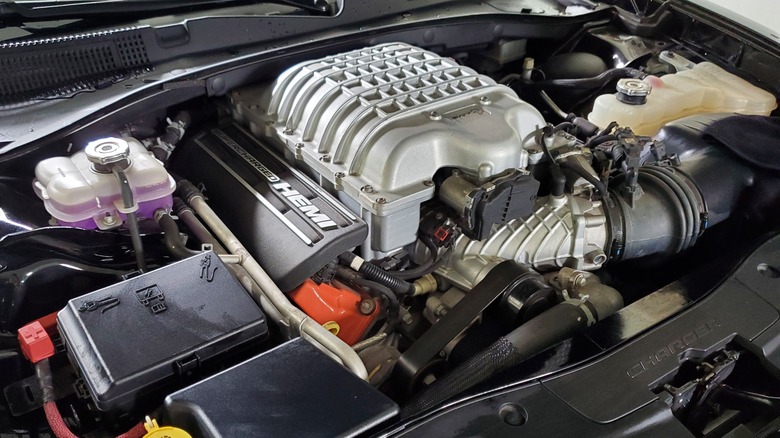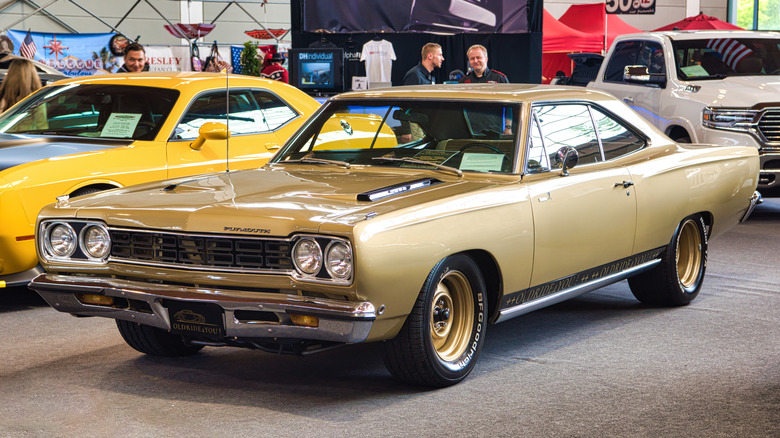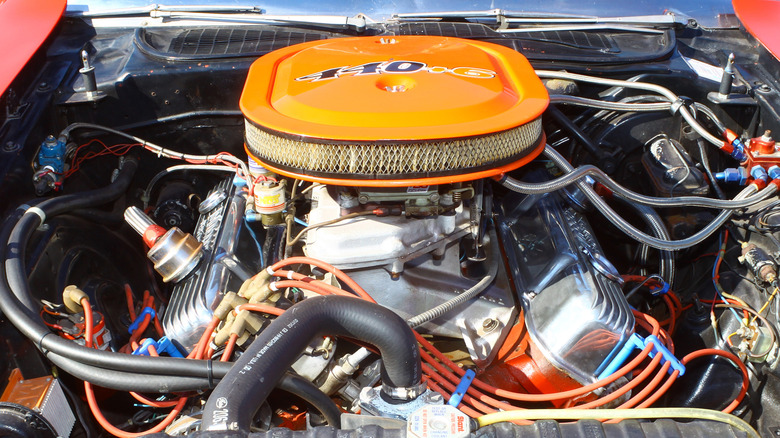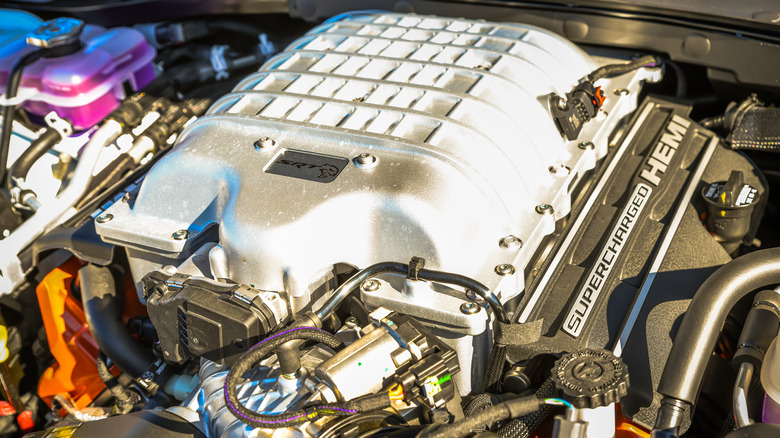
AlohaOla/Shutterstock
Mopar — a portmanteau of MOtor and PARts — had humble beginnings as a brand introduced by Chrysler Corporation in 1937 to sell antifreeze. However, today it’s best associated with decades of providing and servicing parts for high-performance muscle cars from brands like Dodge, Plymouth, DeSoto, Ram, Chrysler, and Imperial.
Chrysler first struck performance gold with the FirePower engines, the first incarnation of what would be later known as the Hemi. These were available from 1951 to 1958 and culminated in a 392 cubic inch engine that could achieve 390 horsepower and 435 lb-ft of torque — impressive numbers for the late 1950s. Great as these engines were, however, they merely laid the foundation for what would come during the true age of the muscle car.
From early ’60s proto-muscle cars like the Dodge Polara to modern equivalents like the Dodge Charger Hellcat, Mopar cars have played host to several excellent and much-loved engines. These engines range from relatively low-powered but ultra-reliable units like the 225 slant-six to huge-displacement fire-breathers like the legendary 426 Hemi and its modern-day descendants — like the 700 horsepower 6.2-liter Hellcat V8 — all of which have earned a place in gearhead lore for various reasons.
As we enter what might be the twilight years of the gas-guzzling, large-displacement V8 engine, let’s look back and celebrate some of the best and most iconic Mopar engines to have ever graced the streets.
383 B-series V8

Dmitry Eagle Orlov/Shutterstock
Chrysler introduced the wedge big block V8s in 1958 to succeed the FirePower Hemi engines available in cars from 1951 to 1958. These wedge V8s came in two forms: raised-deck (commonly referred to as RB) and low-deck (B), with the latter initially available in 350 and 361 cubic-inch in its debut year. These featured in cars like the 1958 DeSoto and were capable engines, with the latter producing 305 horsepower and 400 lb-ft of torque. However, just a year later Chrysler unleashed the definitive version of the B-series big block V8 — the 383.
The 383 was at 361 with a 4.25-inch bore and 3.38-inch stroke. It made its way into all manner of Chrysler, Dodge, and Plymouth cars throughout the 1960s, although it spent most of its early years powering relatively mundane vehicles like the 305 horsepower Chrysler Saratoga. It took until the end of the decade before the 383 started appearing in the engine bays of bonafide muscle cars.
In 1968, the 383 made its way to the Plymouth Road Runner. This souped-up version boasted 335 horsepower and 425 lb-ft of torque. This high-powered version of the 383 would eventually be made available as an option in other Mopar muscle cars, such as the Charger and Super Bee, alongside a tamer 290-horsepower version of the same engine. Chrysler discontinued the B-series 383 V8 in 1971, by which point the 383’s gross power output had dropped to 300 horsepower — or 275 horsepower in its lower-power guise.
413/426 Max Wedge V8
A year after launching the B-series big-block V8s, Chrysler launched a raised-deck (RB) big-block V8 with a longer 3.75-inch stroke and higher 10.72-inch deck height. The RB V8 started as a 383 cubic inch engine due to limited production capacity but came into its own as a 413 cubic inch unit in cars like the 1959 Chrysler New Yorker and 300E, where it produced 380 horsepower in its most potent form.
However, Chrysler offered an even more powerful version of the 413 V8, the Max Wedge. The 413 Max Wedge was a drag-oriented but street-legal engine with an impressive 410 horsepower and 470 lb-ft of torque on tap, thanks to various modifications. These included a higher compression ratio, dual four-barrel carburetors, and a better exhaust. Chrysler made the Max Wedge available as a secret option in 1962 on B-body Mopars such as the Dodge Dart Ram Charger and Plymouth Fury Super Stock.
In 1963, Chrysler took things further with the 426 Max Wedge. The 426 Max Wedge increased the bore to 4.25 inches and was available in two configurations depending on the (unadvertised) sales code a buyer chose. Sales code 08 got owners a 415 horsepower 426 with 11:1 compression, while sales code 09 bumped the horsepower up to 420 thanks to higher 13.5:1 compression. The 426 was available on cars like the 1963 Plymouth Savoy and continued to be available through 1964 on proto-muscle cars like the Dodge Polara, after which the 426 Hemi became Mopar’s go-to 426.
440 RB V8

Barry Blackburn/Shutterstock
The final big-block Mopar RB V8, the 440 V8, which had a 4.32-inch bore and replaced the 413 and 426 V8s in all Chrysler street cars, was introduced in 1965. The 440 debuted as the standard engine in the 1966 Imperial, making a 350 horsepower and 480 lb-ft of torque. Several Mopar brands offered a slightly hotter version, with cars like the Chrysler Newport sporting an optional 365 horsepower 440 V8.
The 440 V8’s power output increased in 1967, with larger exhaust valves and dual exhausts helping it produce 375 gross horsepower and 480 lb-ft of torque. This 440 V8 was available in cars such as the 1967 Plymouth Fury — as the Super Commando engine — and Dodge’s Scat Pack cars like the Dodge Coronet R/T, where it was known as the 440 V8 Magnum. In 1969 came the debut of an even more powerful Six Pack version of the 440 V8. The Six Pack’s triple carburetors pushed the engine to 390 horsepower and 490 lb-ft of torque in cars like the 1970 Dodge Charger 440 Six Pack.
Unlike many iconic big-block Mopar V8s, the 440 V8 lasted through most of the 1970s in trucks and full-size cars, albeit with changes to keep up with changing emissions regulations. Compression dropped to 8.8:1 in 1971, slightly reducing the power output to 330 horsepower — or 250 net horsepower, which was the measurement used going forward. By the time production ended in 1978, the 440 RB V8 was only putting out 195 net horsepower, a far cry from its glory days.
426 Hemi
For many Mopar enthusiasts, the 426 Hemi stands as the definitive Mopar muscle car engine. Sporting hemispherical combustion chambers on top of the tried-and-tested RB big-block V8, the 426 Hemi made between 400 to 425 gross horsepower and was designed as a race-only for NASCAR stock racing and NHRA drag racing. However, the engine’s success in its first year — occupying the top four spots in the 1964 Daytona 500 — prompted NASCAR officials to demand that Chrysler produce street engines to homologate the 426 Hemi for competition.
The 426 Hemi was first made available on a street car in 1965, advertised as the 426 Optional Super Commando engine for the 1965 Plymouth Belvedere — with a disclaimer that it wasn’t recommended for daily driving. It wasn’t until a year later that a proper street-going 426 Hemi would become an option on Mopar muscle cars. The street Hemi was a slightly neutered version of the race engine tweaked for smoothness and daily driving.
Compression dropped from 12.5:1 to 10.25:1, while other changes included more relaxed valve timings, cast iron (instead of aluminum) heads, and new exhaust manifolds. Despite the changes, the 426 Hemi still produced gross numbers of 425 horsepower and 490 lb-ft of torque — although the actual power output may have been closer to 500 horsepower.
The 426 Hemi was an option in many iconic Mopar muscle cars from the late 1960s and early 1970s. It was available in Dodges such as the Challenger (1970-1971) and Charger (1966-1971) and Plymouths like the ‘Cuda (1970-1971). The 426 Hemi lasted until 1972, with fewer than 11,000 units made during its six-year run.
[Image by Trekphiler via Wikimedia Commons | Cropped and scaled | CC BY 3.0]
340 small-block V8
By 1968, the golden era of the muscle car was in full swing, with now-legendary Mopar muscle cars like the 1968 Dodge Charger prowling the streets and tearing up drag strips all across the U.S. Amidst all this, Chrysler released what is likely its most iconic small-block V8, the 340. The 340 was a bored-out version of the existing 318 cubic inch small-block V8, with a 4.04-inch bore coupled to the base engine’s 3.31-inch stroke.
Other improvements over the 318 included high-flow heads, larger cylinder head ports, and higher-performance carburetors. The result was 275 gross horsepower and 340 lb-ft of torque, which made it ideal for compact muscle cars like the 1968 Dodge Dart GTS and 1970 Plymouth Duster 340. A higher-performance Six Pack version was also made available in the 1970 Dodge Challenger T/A and AAR ‘Cuda for homologation purposes. This had a triple-carburetor setup and improved engine airflow, which brought the numbers up to 290 horsepower and 345 lb-ft of torque.
However, more recent tests indicate that Mopar severely underrated the power output of both 340 V8s. MotorTrend tested the basic 340 V8 and recorded 320 horsepower and 368 lb-ft of torque — big numbers for a small car like the Dart GTS. The Six-Pack’s three-carb setup increased the numbers to 356 and 382, respectively. Chrysler discontinued the 340 V8 after 1973. However, parts of it would live on in a special high-performance version of its 360 cubic inch sibling.
[Image by Greg Gjerdingen via Wikimedia Commons | Cropped and scaled | CC BY 2.0]
360 small-block V8
The Mopar 360 small block V8 debuted in 1971, and carried the hallmarks of an engine debuting into a post-Clean Air Act world. The 360, which had a 4.00-inch bore and 3.58-inch stroke, launched as a low-compression engine (8.7:1) with a two-barrel carburetor. Chrysler first made the 360 V8 available in the 1971 Plymouth Fury and Dodge Polara, with a net power output of 175 horsepower and 285 pound-feet of torque.
Despite the 1970s being a terrible decade for muscle cars (and the V8 engine), the 360 V8 had a better time than most. After discontinuing the 340 V8, Chrysler engineers added its quad-barrel carburetor and performance camshaft to the 360, resulting in a special edition with 245 gross horsepower and 320 pound-feet of torque. By the end of the 1970s, Dodge immortalized this version of the 360 V8 in Mopar lore by using it to power the Li’l Red Express, a factory hot-rodded version of the D-series pickup truck.
While the 360 V8 would never reach the same heights again, the engine remained in the Chrysler stable as a truck engine up until the early 2000s. Fuel injection came in 1988, while 1993 saw the 360 upgraded to the 5.9-liter Magnum engine, which peaked at 245 horsepower and 345 pound-feet of torque in 1998’s Jeep Grand Cherokee 5.9 Limited. The Magnum continued to be a mainstay — with millions produced — up until 2003, when Chrysler replaced it with the 5.7-liter Hemi V8.
[Image by Nickmix01 via Wikimedia Commons | Cropped and scaled | CC BY-SA 4.0]
5.7-liter Hemi V8
For most of the 1990s and into the early 2000s, the 360-based 5.9-liter Magnum V8 was the only Chrysler engine that truly kept the spirit of classic Mopar muscle car engines alive. However, that all changed in 2003, when Chrysler resurrected the Hemi name for an all-new 5.7-liter V8 to power that year’s Dodge Ram 1500, 2500, and 3500 trucks.
Hemi wasn’t just a marketing gimmick for the new engine, either. The new 5.7-liter engine sported hemispherical combustion chambers similar to those of its predecessors, living up to the Hemi name. Other notable features included aluminum cylinder heads and dual spark plugs, akin to some classic Mopar drag-racing engines. This first-generation 5.7-liter Hemi was good for 345 horsepower and 375 lb-ft of torque in the 2003 Ram truck and would later be the standard engine for the revived Dodge Charger in 2006.
Chrysler upgraded the 5.7-liter Hemi V8 in 2009 to coincide with the resurrection of another classic Mopar name, the Dodge Challenger. Among the upgrades was the introduction of variable valve timing, which significantly improved fuel economy and power. The 2009 version also had tweaked cylinder heads with better airflow, increased compression, and a new engine block. The final result of the changes was a cool 375 horsepower and 404 pound-feet of torque.
While the 5.7-liter Hemi isn’t the most powerful modern Mopar Hemi engine, it’s ground zero for every other modern Hemi V8 since — including monsters like the 6.2-liter Hellcat V8. For that, it deserves a place in the history books.
6.2-liter Hellcat V8

Keith J Finks/Shutterstock
In the pantheon of modern muscle car engines, few have quite the same cachet as Chrysler’s 6.2-liter Hellcat V8 engine and its derivatives. Starting at 707 horsepower and 650 pound-feet of torque and climbing upward in its more powerful forms, the Hellcat V8 ranks as one of the most powerful motors ever to inhibit the engine bay of a Mopar muscle car.
The Hellcat V8 emerged in 2015 as a culmination of the various modern Hemi V8s of the 2000s. It had the 4.09-inch bore of the 6.4-liter Hemi V8 and the 3.58-inch stroke from the classic 5.7-liter Hemi while also sharing the former’s cylinder heads and short block. However, the vast majority of the 6.2-liter Hellcat V8’s components were all new to the family — including the supercharger. The Hellcat V8’s twin-screw supercharger displaced 2.3 liters, giving cars like the Challenger SRT Hellcat impressive straight-line performance.
The basic Hellcat V8 was only the start of it, though. In the following years, Dodge treated gearheads and Mopar fanatics to various high-powered variations on the Challenger. The 808-horsepower Challenger SRT Demon kicked things off in 2018, but the peak of the 6.2-liter Hemi V8 has to be the 1,025-horsepower unit inside the 2023 Dodge Challenger SRT Demon 170. No matter the guise, though, the 6.2-liter Hellcat V8 will likely go down in history as one of the greatest Mopar V8s ever — and perhaps one of the last ones, too, as Dodge muscle cars are going electric for 2024.
225 Slant Six
Most classic Mopar V8s were relatively short-lived, with only a couple remaining in production after the muscle car era ended in the mid-1970s. Even then, they were arguably shadows of their former selves, with lower compression and various emissions-related modifications leading to much lower power output. Still, one Mopar motor lasted the better part of two decades and even featured in a handful of muscle cars: the 225 cubic inch Slant Six.
The Slant Six was never a powerhouse, with the largest 225-CI version producing a comparatively measly 145 gross horsepower and 215 pound-feet of torque. This was good enough for compact cars like the Dodge Dart, where it remained as the base engine option well into the 1970s, but it was nothing to really write home about. Despite that, the 225 Slant Six developed a reputation for durability over the years, resulting in millions of units being produced from 1960 to 1987.
Of course, this is Mopar we’re talking about, so it shouldn’t surprise you that Chrysler offered a higher-performance Slant Six during its lifetime. The Hyper-Pak option, available on the Plymouth Valiant and Dodge Lancer in 1961 and 1962, offered upgrades such as a four-barrel carburetor and higher-performance camshaft. These helped push the power output on the 225 Slant Six to an impressive 196 gross horsepower — great for the early 1960s but not as competitive these days. However, enthusiasts have kept the 225 Slant Six alive, with modern builds capable of producing 300 to 400 horsepower with the right components.